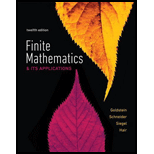
Gambler’s Ruin Exercises 19 and 20 refer to Example 7.
Job Mobility The lawyers at a law firm are either associates or partners. At the end of each year, 30% of the associates leave the firm, 20% are promoted to partner, and 50% remain associates. Also, 10% of the partners leave the firm at the end of each year. Assume that a lawyer who leaves the firm does not return.
a. Draw the transition diagram for this Markov process. Label the states A, P, and L.
b. Set up an absorbing stochastic matrix for the Markov process.
c. Find the stable matrix.
d. What is the expected number of years that an associate will be in the firm before leaving?
e. In the long run, what percent of the lawyers will be associates?
Want to see the full answer?
Check out a sample textbook solution
Chapter 8 Solutions
Finite Mathematics & Its Applications (12th Edition)
- 6. Let X be a random variable taking values in (0,∞) with proba- bility density function fx(u) = 5e5u u > 0. Total marks 8 Let Y = X2. Find the probability density function of Y. [8 Marks]arrow_forward5. Let a probability measure P on ([0,3], B([0,3])) be given by 1 dP(s): = ½ s² ds. 9 Consider a random variable X : [0,3] → R given by X(s) = s², sc [0,3]. S Total marks 7 Find the distribution of X. [7 Marks]arrow_forwardRefer to page 24 for solving a differential equation using Laplace transforms. Instructions: Take the Laplace transform of the given equation, applying initial conditions appropriately. ⚫ Solve the resulting algebraic equation and find the inverse transform. Provide step-by-step solutions with intermediate results and final verification. Link: [https://drive.google.com/file/d/1wKSrun-GlxirS31Z9qoHazb9tC440 AZF/view?usp=sharing]arrow_forward
- Refer to page 30 for deriving the Euler-Lagrange equation for an optimal control problem. Instructions: • Use the calculus of variations to derive the Euler-Lagrange equation. Clearly define the functional being minimized or maximized. Provide step-by-step derivations, including all necessary boundary conditions. Avoid skipping critical explanations. Link: [https://drive.google.com/file/d/1wKSrun-GlxirS3IZ9qoHazb9tC440 AZF/view?usp=sharing]arrow_forwardRefer to page 32 for solving a linear-quadratic regulator (LQR) problem. Instructions: • Formulate the cost functional and state-space representation. • Derive the Riccati equation and solve it step-by-step. Clearly explain how the optimal control law is obtained. Ensure all matrix algebra is shown in detail. Link: [https://drive.google.com/file/d/1wKSrun-GlxirS31Z9qoHazb9tC440AZF/view?usp=sharing]arrow_forwardRefer to page 14 for solving a linear first-order differential equation. Instructions: • Convert the equation into its standard linear form. • Use integrating factors to find the solution. Show all steps explicitly, from finding the factor to integrating and simplifying the solution. Link [https://drive.google.com/file/d/1wKSrun-GlxirS31Z9qoHazb9tC440AZF/view?usp=sharing]arrow_forward
- Refer to page 10 for a problem involving solving an exact differential equation. Instructions: • Verify if the equation is exact by testing әм მყ - ƏN მე If not exact, determine an integrating factor to make it exact. • Solve step-by-step, showing all derivations. Avoid irrelevant explanations. Link: [https://drive.google.com/file/d/1wKSrun-GlxirS31Z9qo Haz b9tC440AZF/view?usp=sharing]arrow_forwardRefer to page 10 for a problem involving solving an exact differential equation. Instructions: Verify exactness carefully. ⚫ If the equation is not exact, find an integrating factor to make it exact. Solve step-by-step and ensure no algebraic steps are skipped. Provide detailed explanations for each transformation. Link: [https://drive.google.com/file/d/1wKSrun-GlxirS31Z9qoHazb9tC440 AZF/view?usp=sharing]arrow_forwardRefer to page 34 for deriving and applying Pontryagin's Maximum Principle. Instructions: ⚫ Define the Hamiltonian for the given control problem. • • Derive the necessary conditions for optimality step-by-step, including state and co-state equations. Solve the resulting system of equations explicitly, showing all intermediate steps. Link: [https://drive.google.com/file/d/1wKSrun-GlxirS31Z9qoHazb9tC440AZF/view?usp=sharing]arrow_forward
- Refer to page 20 for solving a separable differential equation. Instructions: ⚫ Separate the variables explicitly. • Integrate both sides carefully, showing intermediate steps. • Simplify the final result and provide the explicit or implicit solution as required. Link: [https://drive.google.com/file/d/1wKSrun-GlxirS31Z9qoHazb9tC440AZF/view?usp=sharing]arrow_forwardRefer to page 16 for a problem involving solving a second-order linear homogeneous differential equation. Instructions: • Analyze the characteristic equation and address all possible cases (distinct, repeated, and complex roots). • Show detailed steps for deriving the general solution. • Verify solutions by substitution into the original equation. Link: [https://drive.google.com/file/d/1wKSrun-GlxirS31Z9qoHazb9tC440AZF/view?usp=sharing]arrow_forwardNeed help with question?arrow_forward
 Elementary Linear Algebra (MindTap Course List)AlgebraISBN:9781305658004Author:Ron LarsonPublisher:Cengage Learning
Elementary Linear Algebra (MindTap Course List)AlgebraISBN:9781305658004Author:Ron LarsonPublisher:Cengage Learning
